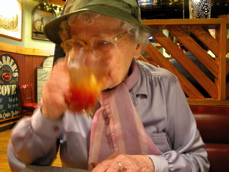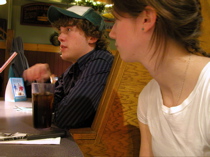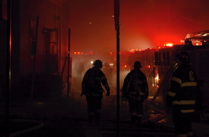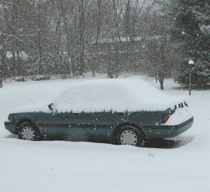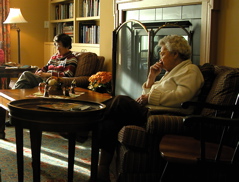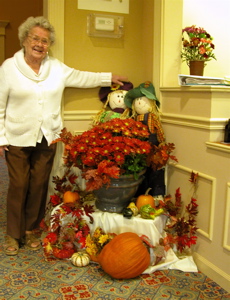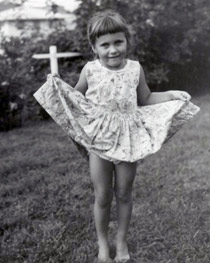Adam Kibbe
The following is admittedly long by blog standards, but short for the experience. And of the linked gallery of 75 pictures, you should know that I started with almost 250. I hope someone makes it through the text and/or the pictures and enjoys …
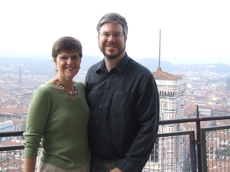
Frequent Flyer airplane tickets stretch the definition of free – specific travel dates, remote Logan terminals, “puddle jumper” jets, 3-hour layovers in both NYC and Brussels. But never mind — safe arrival is paramount, our destination more than worthy, even the return “price” of an overnight layover in Brussels actually a gift, as we thus came to experience a second European capital, and one which may never otherwise have been on our agendas.
After 20-plus real-time hours of travel we debarked the big, blue (4-Euro) SITA bus in the Santa Maria Novella terminal on the edge of the city center and set off on foot into a land of another language on the first of many perambulations about this gorgeous city, our suitcases bumping along behind us on the cobblestones. We would see versions of ourselves at that moment several times over the next week, a stream of arriving or departing tourists ever-present there.
That first walk was a bit hazy and narrow-focus, as I tried to navigate from one consult with our map, intent not on sightseeing but just on laying our burdens down, bootstrap-learning the basics – like where they hide their street names and whether people jaywalk. Awareness was dimmed by fatigue, which mercifully somewhat blunted the assault of incredible urban density — people stream towards you down sidewalks inadequate to the volume, cars and scooters barreling along millimeters away, and so much is unfamiliar. But midway on our beeline we found ourselves before the Duomo, and while not yet ready to truly behold and perceive it, its grandeur began to massage into us the message that we’d arrived.
Somehow we unerringly found Via Sant’ Egidio and the Palazzo Galletti B&B amongst the Byzantine streets and climbed the lengthy first-floor stone steps around four sides of a spare, columned courtyard up to the welcoming reception desk, from whence we were shown to our modestly palatial room, complete with old frescos, parti-colored hand-hewn 5-meter-high coffered ceiling, and a marble bathroom. And with a bottle of Chianti from the owners’ own vineyard awaiting beside a pair of glasses and corkscrew. Attention to detail. We’d drink the quite passable Chianti on our balcony for lunch several days later, but after unpacking and changing we immediately headed back out onto our bustly sidestreet and into the pleasant fall evening to see something of Firenze.
Save for one partially rainy day, we had spectacular weather there – 60’s (mid-teens Celsius) and mostly full sun. That first evening was plenty warm enough for outside dining, and after a couple hours walking that took us through the Piazza della Signoria, past the Uffizi and down to the Arno and the Ponte Vecchio and back, we settled beneath some hanging teak-and-canvas canopies beside the curved street behind the Duomo at an empty, lantern-lit sidewalk restaurant, quite ready to rest. Yes, we know restaurants with crowds are usually best, but it turns out the Italians don’t even start thinking about dinner until past 8:00 and we were hungry tourists who wanted to dine near home and shortly thereafter crash. My rusty Italian got us unidentified glasses of red & white wine, a tasty, oil-drizzled bowl of pumpkin-pasta soup and a shared salad, then some fantastic handmade arugula-garlic ravioli in cream sauce for me and a plate of tuna, pasta and tomatoes for Tricia. Then we were off for our first gelato along what we would later come to think of (and thereafter avoid) as Firenze’s Newbury Street – la Via dei Calzaiuoli — then blissfully home and to bed.
The next day we started exploring in earnest. But first the soon-to-be-familiar daily breakfast in the Palazzo’s plaster-vaulted breakfast room, complete with fresh-brewed espresso, a mountain of fruit (including ‚ÄúSicilian pears‚Äù, a cactus fruit), yogurt, fresh and packaged brioche, hazelnut cookies, toast (with jellies and/or Nutella), blood-orange juice, and cereal if one wanted (we never did). And thus fortified, we hit the bricks. Or cobbles ‚Ķ
Such a new place and pace. Narrow, crowded streets lined with diagonally-parked scooters, and swarms of live ones veering amongst tiny Smart cars and electric postal vans; occasionally we’d have to flatten ourselves to let pass slow-moving buses whose mirrors almost scraped the side walls. And people. Lots of people. The sidewalks range from implausibly narrow to mere curbings where an old wall juts out, and casual strolling without strategy is rare. A constant sort of game of chicken is played — I never figured out if there were rules, exactly, but my size came in handy as I learned to protect my path (and that of Tricia often behind me) by body language and by adopting the perceived expression of calm, studied indifference that says, “I’m clear I’ve got a right to my small piece of the sidewalk, one of you three move”. No animosity, mind you, just part of the Italian “cool”, I think. In the generic urban milieu the Italians register little – no disdain for tourists, no aggression, rarely hurry, but no warm “Buon’ giornos” either. Just on their way from somewhere to somewhere else in an environment that requires that your personal space be projected a few millimeters lest you be run down, but no more than is necessary lest one engender conflict.
When they meet a friend, though, they light up like day breaking. Smiles, hugs, kisses on the cheek, pausing to catch up. Passing hellos are rare, Italians seemingly preferring more personal lingering. Solo persons in contact with others via cell phone stand in place as if truly present elsewhere, intent on their conversation, animatedly waving their hands about as if their listener could see them. And pairs of men and women are everywhere walking arm-in-arm, further espousing personal contact in the otherwise impersonal, hectic street scene. We learned after awhile how to walk at our own pace — when we could stroll arm-in-arm, when single-file; when to step into the street to pass someone without being flattened by a speeding taxi or silent bicyclist; how to step aside without a glance over one’s shoulder to let pass the fast-approaching local who actually had a destination. Not by learning anything consciously, but by becoming attuned to the city. That there are equally innocently bewildered tourists everywhere means there’s no attainable mob oneness, but it got easier. And we gazed more.
Hard to pay attention to forward eye level when there’s so much going one to all sides and above. Ancient architecture, shops of all descriptions, scads of eye-catching Italians. Not so much riveting beauty, mind you, but while many are beautiful, Italians are definitely almost uniformly ‚Äúcool‚Äù, right down to the mammas with their bambini. Mostly in blacks and leather tones, with sleek leather jackets and perfect jeans, hip squarish specs, just the right amount of jewelry, and generally well-coiffed. Fascinating footwear, too. Even those that tended to name- or sports-brand sloppy brashness had hip red-suede tennis shoes, or an earring or something to turn the gaudy gauche into idiosyncratic groovy. Any one of whom would stand out in some other environment, but en masse it sort of felt natural, as if the city were a dry reef wherein many species of colorful bipeds congregated as do fish about a coral reef, interacting or not, ducking in and out of the coffee shops that beckoned every 10 meters or so for their ritual espressos. Only the occasional matron in grey or black defies the Live Hip or Die unspoken credo of Firenze, wearing their sensible square-nosed shoes instead of the ubiquitous Wicked-Witch-of-the-West absurdly pointy ones currently en vogue.
And above it all the craggy stone architecture, centuries if not millennia old, with painted wooden shutters and lovely plant boxes, the faces of old clocks on towers, the blue autumn sky in corniced slivers above the winding streets, all draw one’s wonder and attention. The whole city is hand-hewn stone, redolent of the work of ages of humanity, its enduring authenticity solidly about you everywhere. Firenze may change a little in its occupants and details, but save for the contents of any given storefront or trattoria, you know it has been and will be thus quite a long time, the scooters and Smarts, and gawky tourists and hip Italians all just this generation’s witness to the city’s massive and patient history.
We saw as much as we could take in, from the delightfully quotidian to The Official Cultural Treasures. We daily quickstepped past mobs of guided tourists with earpieces in place and cameras aloft in rotating endless watch before the amazing (but reproduction) bronze Baptistry doors of Ghilberti, but stood among them in unabashed awe before Michelangelo’s David in the Accademia, absorbing the poised, masculine confidence radiating from the recently-cleaned white marble that quite transcends stone. We bought 2-Euro panini and crostini in side-alley cafes and washed them down with coffee that never failed to be excellent, sitting at length at tiny tables observing while old friends and regulars came and went in short bursts of jocular urban camaraderie. In the Uffizi Tricia gasped as we entered Yet Another Gallery and came face-to-face with the original of Filippo Lippi’s La Vergine con Bambino e Due Angeli, a reproduction excerpt of which, having moved Tricia to tears years ago, resides in our home. And in the Santa Croce cathedral complex we experienced transporting silence before the remains of the robes of St. Francis of Assisi, modestly enshrined behind glass in a room fully paneled in surpassing woodwork, suffused with angled sunlight through pebbled glass. A rich hour-plus was spent in a wine shop so tiny three of us filled it, Tricia and I listening intently to the sweating proprietor’s wonderful Italianate English, occasionally lapsing into Italian when color failed him, spinning the tale of the Sangiovese grape in Toscania — the history, blunders and future of Tuscan wines, a personal product in a global age. And at night before and after dinner, we’d wander the streets extemporaneously, both in areas we’d been and others we’d not, all new in the different light and energy of a citizenry changing clothes from its business brusque to its nightlife. Nowhere did we feel unsafe. On the most deserted streets a twenty-something hottie might suddenly glide by on a bicycle so unstylish it, too, was cool, her flowing hair and solo presence seeming to declare the darkened neighborhood threat-free.
When we’d had enough of the city center we ambled one day across the obscenely commercial Ponte Vecchio and up the Via de’ Guicciardini past the Palazzo Pitti to the gated entry to the Giardino di Boboli, and into its vast open space. Open parks or places to sit (besides walls and steps) are rare to nonexistent in Firenze. Benches and trees and quiet were a welcome decompression as we gazed at the crumbling statuary and greening fountains, and wandered the myriad hedged paths uphill back towards the Arno. From the apex courtyard of the hilltop ceramics museum (with a bathroom, if you ask ‚Ķ !) we had views into the surrounding quintessential Tuscan landscapes, and nearer the Arno spectacular views of the Duomo and towers of the city center, the remove giving fresh perspective.
But to know a city is to know its people and their places. Our second day we asked one of our hosts (the only day we saw this particular woman) for recommendations of restaurants, and she made us a reservation at one of them – for 7:45, 15 minutes before it regularly opens (we’d ignorantly requested 7:30, way too early for most Italians — a genteel and unnecessarily generous compromise). The streets we walked towards it were away from where we’d been and had a particularly neighborhood feel to them, with barely a tourist to be seen. Unfancy, but nice. We were greeted at “Il Giova” by the beaming, casually dressed owner, a trim 30-something woman who seemed to know everyone who walked by, ducking outside periodically to kiss cheeks and coddle babies. At that hour a reservation seemed quite beside the point, and she showed us to one of the few two-person tables in this mostly empty 8-table trattoria. With a nice bottle of Vernaccia di San Gimignano to savor – the only Tuscan white – we settled in to await our vegetarian version of the house antipasto, chatting, planning and surreptitiously observing our neighbors.
A young family of three beside us noshed on calamari which the father later pronounced the best he’d ever had — their child ate buttered spaghetti but was open to samples of all his parents were eating. After awhile a young couple came in and sat down beside us, poised but effusively vibrant, their rapid Italian beyond my eavesdropping. The woman gave the man a gift of a ring, which he accepted easily, and the owner chatted with them familiarly from behind the counter. They only had filetto, and a bottle of her best wine – Morellino di Scansano Tenuta Poggio Brigante, Riserva “Arsura” 2002 (I later looked for it in vain in wine shops). Then came our antipasto, which had nothing in it I’ve ever had in any other antipasto and was superb. The place’s pace would have seemed glacial had we not felt we’d found a place we could stay forever. We actually saw a couple come and leave, too impatient for the owner to “notice” them – “Your loss,” we murmured to each other. But not to worry – before we left hours later, people were waiting outside.
I only had a primi that night ‚Äì gnocchi alla zucca di gialla ‚Äì but the improbably light pasta pillows in their yellow zucchini flower sauce was ambrosial, Tricia’s duck in port and fig sauce also magnificent. Simple, honest, perfectly prepared food, her lone cohort in the kitchen obviously a master, and she the sort of Italian Audrey Hepburn hostess one unrequitedly but helplessly falls in love with. After coffees and a shared tiramisu, we asked (in Italian) if we needed reservations to come back, and she smiled grandly and said ‚ÄúOf course not‚Äù ‚Ķ We passed her a couple nights later on our way to a brick-oven pizza place we’d noticed on our way home that night, and though engaged in conversation with someone, she recognized and greeted us. And so yet a few nights later, for our last night in Firenze, we made ‚ÄúIl Giova‚Äù our only repeat, a meal perhaps a bit less surprisingly memorable in its details, but grand for the feeling of belonging. That second visit we fashionably came a bit later, and it was more crowded. A trio of actually quite excellent street troubadors briefly entertained, and towards closing two gorgeous young Bohemian women came in with free samples of Amarone liqueur, apparently a common marketing ploy there, but news to us. We declined, and the owner came by to make sure we’d understood that it was free, and we happily said quite honestly that we were simply too stuffed. At least, I think that’s what I said. As we were saying our goodbyes I thanked her for her patience with my Italian ‚Ķ
There are, of course, architectural and cultural marvels to describe and other adventures to tell, but I’ll fast forward. The unforgettable climb up the Duomo in unexpected near-seclusion and its payoff 360 view. The bus trip to Siena through the rolling hills, and the tourist trappings and cursing gypsies that awaited us (and overpaying by over double an astonished late-night Florentine bartender that same night when we felt we needed to exorcise Siena’s luchre demons and dispose of all our “tainted” cash). Breaking my tooth on rum-nougat gelato outside a shop on the south end of the Ponte Santa Trinita on our second day, and days later seeking out the famous Bar Vivoli gelateria, undaunted. The shopping. The worthy, exhausted pain of so much walking. The incredible custom sandwiches from the previously uninvestigated oil shop three doors down from our B&B, to which our local Internet impresario turned us on, and which we ate on our balcony with the house Chianti one rainy afternoon, and again beatifically in the airport the day we left (okay, two repeats … ).
Though but a day there plus a touch-and-go on our way in, Bruxelles deserves its own telling, from abstract first glance from the air before dawn, precisely-defined roadways draped like strings of pearls on the barely visible forms of the land, to our return a week later to intimate experience of its incomprehensibly complex public transit; our slightly frayed tucked-away hotel smelling of cannabis, and its expatriate English curmudgeon hotel owner pleading to be paid in cash; from fabulous Belgian beers at lunch and street waffles made while you watched, to dining on couscous alone in a smashing but deserted corner restaurant after kirs, while South American music played in delightful incongruity. Grey skies but occasional sharp light; cold wind, uncluttered sidewalks; free churches, public parks. Loved it. Hated it.
Came home.
The pictures take me back, but I was ready to leave. Time away from all that is familiar sharpens one’s appreciation, both of the world at large and of the microcosm of our individual lives. Italy was not so foreign, and I miss the food and the spark of its people already. And I liked working on my rusty Italian, a passionate language which is sensual to hear and to speak. The urban pace was wearing, though, and I could probably die complete without ever seeing another Renaissance painting involving the life or torture and death of Christ (or the annunciation or coronation of his mother), but I would very much like to return to Tuscany someday and seek out its less urban campagna, reindulge in its foods and wines and history. Dip a mattonella biscotti in a thimble of vin santo after a fabulous dinner and watch the sun set on the cypresses and old stone walls with good friends near at hand.
Anybody up for renting a villa in Tuscany for a few weeks one summer?
